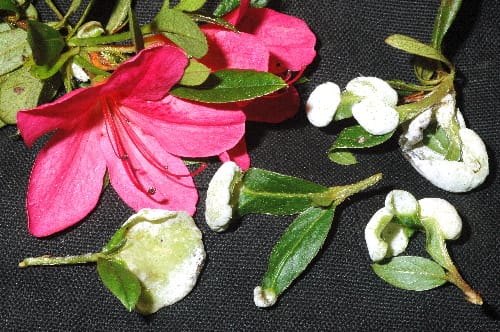Source(s): Laurene Hall
Azalea leaf gall is a very common and widespread fungus disease that occurs in early spring on new azalea foliage. The leaves become thickened, curled, fleshy and pale green to white in color. Fortunately, this disease is more alarming than damaging.
Description
Caused by a fungus, Exobasidium vaccinii, which is dormant in the developing buds from one year to the next. When bud growth begins in the spring, the pathogen renews activity also, and one or more of the leaves on the shoot may develop symptoms. A spore-bearing hymenium is eventually produced which completes its development on exposed leaf surfaces. Spores are blown about by air currents, some of them lodge on the plant and finally invade leaf buds. The actual damage to plants is not nearly so important as it appears to be. However, if disease is severe, the vigor of the plant can be affected due to the loss of young leaves.
Detection
First noticed soon after leaf buds open in the spring. All or only part of the individual leaf may be affected. Part of the leaf becomes distorted with a pale green to whitish, bladder-like thickening. When young, the thickened, fleshy-like leaf is covered with a white growth. As the galls age they turn brown, dry up and fall to the ground. Occasionally, a black coating may develop on the surface of the gall, particularly during rainy weather, which results from secondary invasion of the galls by the fungus Pestalotia.
Control
- Handpick or prune out and destroy (burn) galls.
- Spray with recommended fungicides, such as Daconil 2787 or Mancozeb.
- Serious outbreak in large plantings: spray in early spring when leaf buds just begin to open and at two-week intervals (if spring is relatively dry) through early summer (mid-June) with Bordeaux mixture which may reduce incidence of disease in the following season. Timing of sprays is critical because the spores over-winter in the bark and bud scales.
Resource(s): Common Landscape Diseases In Georgia
Center Publication Number: 44
- Leaf Spots - September 24, 2013
- Needle Blight - September 24, 2013
- Dollar Spot - September 23, 2013
